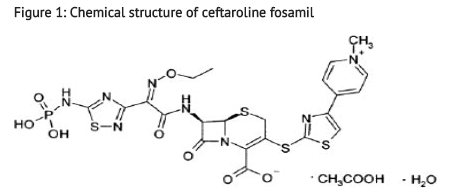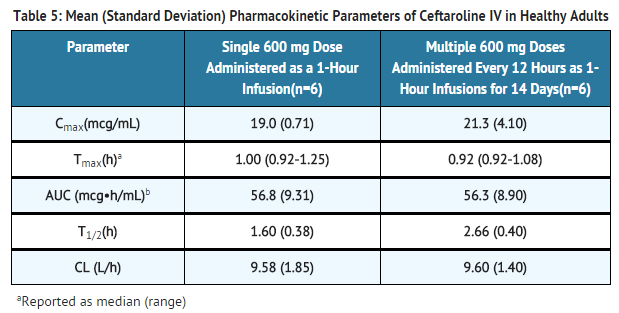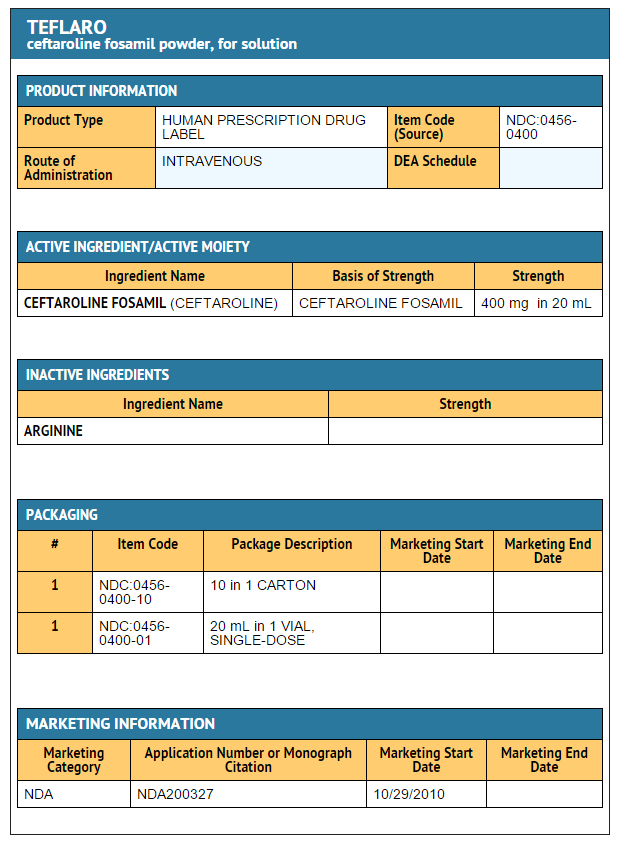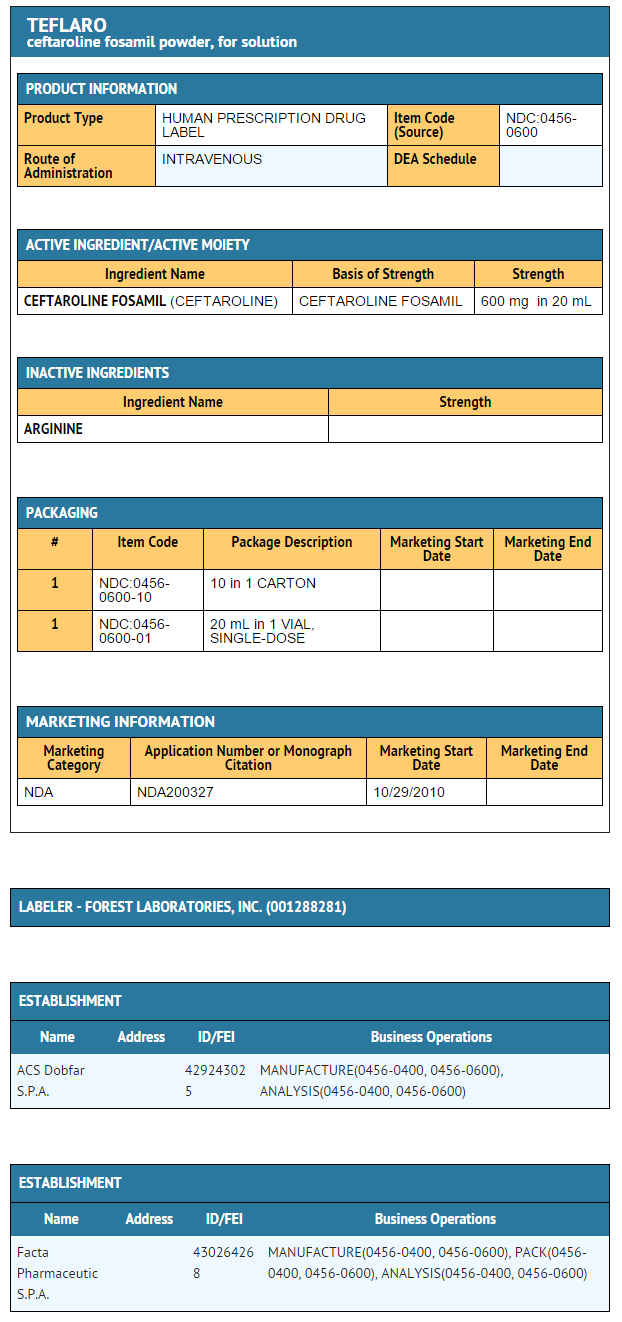Ceftaroline fosamil
Editor-In-Chief: C. Michael Gibson, M.S., M.D. [1]; Associate Editor(s)-in-Chief: Gloria Picoy [2]
Disclaimer
WikiDoc MAKES NO GUARANTEE OF VALIDITY. WikiDoc is not a professional health care provider, nor is it a suitable replacement for a licensed healthcare provider. WikiDoc is intended to be an educational tool, not a tool for any form of healthcare delivery. The educational content on WikiDoc drug pages is based upon the FDA package insert, National Library of Medicine content and practice guidelines / consensus statements. WikiDoc does not promote the administration of any medication or device that is not consistent with its labeling. Please read our full disclaimer here.
Overview
Ceftaroline fosamil is a 5th generation cephalosporin that is FDA approved for the treatment of acute bacterial skin and skin structure infections and community-acquired pneumonia. Common adverse reactions include diarrhea, nausea and rash.
Adult Indications and Dosage
FDA-Labeled Indications and Dosage (Adult)
Ceftaroline fosamil is indicated for the treatment of patients with the following infections caused by susceptible isolates of the designated microorganisms.
Acute Bacterial Skin and Skin Structure Infections
- Caused by susceptible isolates of the following Gram-positive and Gram-negative microorganisms: Staphylococcus aureus (including methicillin-susceptible and -resistant isolates), Streptococcus pyogenes, Streptococcus agalactiae, Escherichia coli, Klebsiella pneumoniae, and Klebsiella oxytoca.
- Dosage: 600 mg administered every 12 hours by intravenous (IV) infusion over 1 hour for 5-14 days.
Community-Acquired Bacterial Pneumonia
- Caused by susceptible isolates of the following Gram-positive and Gram-negative microorganisms: Streptococcus pneumoniae (including cases with concurrent bacteremia),Staphylococcus aureus (methicillin-susceptible isolates only), Haemophilus influenzae, Klebsiella pneumoniae, Klebsiella oxytoca,andEscherichia coli.
- Dosage: 600 mg administered every 12 hours by intravenous (IV) infusion over 1 hour for 5-7 days.
Off-Label Use and Dosage (Adult)
Guideline-Supported Use
There is limited information regarding Off-Label Guideline-Supported Use of Ceftaroline fosamil in adult patients.
Non–Guideline-Supported Use
There is limited information regarding Off-Label Non–Guideline-Supported Use of Ceftaroline fosamil in adult patients.
Pediatric Indications and Dosage
FDA-Labeled Indications and Dosage (Pediatric)
Safety and efficacy not established in children
Off-Label Use and Dosage (Pediatric)
Guideline-Supported Use
There is limited information regarding Off-Label Guideline-Supported Use of Ceftaroline fosamil in pediatric patients.
Non–Guideline-Supported Use
There is limited information regarding Off-Label Non–Guideline-Supported Use of Ceftaroline fosamil in pediatric patients.
Contraindications
- Ceftaroline fosamil is contraindicated in patients with known serious hypersensitivity to ceftaroline or other members of the cephalosporin class.
- Anaphylaxis and anaphylactoid reactions have been reported with ceftaroline.
Warnings
Hypersensitivity Reactions
Serious and occasionally fatal hypersensitivity (anaphylactic) reactions and serious skin reactions have been reported in patients receiving beta-lactam antibacterials. Before therapy with Teflaro is instituted, careful inquiry about previous hypersensitivity reactions to other cephalosporins, penicillins, or carbapenems should be made. If this product is to be given to a penicillin- or other beta-lactam-allergic patient, caution should be exercised because cross sensitivity among beta-lactam antibacterial agents has been clearly established.
If an allergic reaction to Teflaro occurs, the drug should be discontinued. Serious acute hypersensitivity (anaphylactic) reactions require emergency treatment with epinephrine and other emergency measures, that may include airway management, oxygen, intravenous fluids, antihistamines, corticosteroids, and vasopressors as clinically indicated.
Clostridium difficile-associated Diarrhea
Clostridium difficile-associated diarrhea (CDAD) has been reported for nearly all systemic antibacterial agents, including Teflaro, and may range in severity from mild diarrhea to fatal colitis.
Treatment with antibacterial agents alters the normal flora of the colon and may permit overgrowth ofC. difficile.
C. difficileproduces toxins A and B which contribute to the development of CDAD. Hypertoxin-producing strains ofC. difficilecause increased morbidity and mortality, as these infections can be refractory to antimicrobial therapy and may require colectomy. CDAD must be considered in all patients who present with diarrhea following antibiotic use. Careful medical history is necessary because CDAD has been reported to occur more than 2 months after the administration of antibacterial agents.
If CDAD is suspected or confirmed, antibacterials not directed againstC. difficileshould be discontinued, if possible. Appropriate fluid and electrolyte management, protein supplementation, antibiotic treatment ofC. difficile, and surgical evaluation should be instituted as clinically indicated.
Direct Coombs' Test Seroconversion
Seroconversion from a negative to a positive direct Coombs' test result occurred in 120/1114 (10.8%) of patients receiving Teflaro and 49/1116 (4.4%) of patients receiving comparator drugs in the four pooled Phase 3 trials.
In the pooled Phase 3 CABP trials, 51/520 (9.8%) of Teflaro-treated patients compared to 24/534 (4.5%) of ceftriaxone-treated patients seroconverted from a negative to a positive direct Coombs' test result. No adverse reactions representing hemolytic anemia were reported in any treatment group.
If anemia develops during or after treatment with Teflaro, drug-induced hemolytic anemia should be considered. Diagnostic studies including a direct Coombs' test, should be performed. If drug-induced hemolytic anemia is suspected, discontinuation of Teflaro should be considered and supportive care should be administered to the patient (i.e. transfusion) if clinically indicated.
Development of Drug-Resistant Bacteria
Prescribing Teflaro in the absence of a proven or strongly suspected bacterial infection is unlikely to provide benefit to the patient and increases the risk of the development of drug-resistant bacteria.
Adverse Reactions
Clinical Trials Experience
There is limited information regarding Ceftaroline fosamil Clinical Trials Experience in the drug label.
Postmarketing Experience
There is limited information regarding Ceftaroline fosamil Postmarketing Experience in the drug label.
Drug Interactions
No clinical drug-drug interaction studies have been conducted with Teflaro. There is minimal potential for drug-drug interactions between Teflaro and CYP450 substrates, inhibitors, or inducers; drugs known to undergo active renal secretion; and drugs that may alter renal blood flow.
Use in Specific Populations
Pregnancy
Pregnancy Category (FDA): B Developmental toxicity studies performed with ceftaroline fosamil in rats at IV doses up to 300 mg/kg demonstrated no maternal toxicity and no effects on the fetus. A separate toxicokinetic study showed that ceftaroline exposure in rats (based on AUC) at this dose level was approximately 8 times the exposure in humans given 600 mg every 12 hours. There were no drug-induced malformations in the offspring of rabbits given IV doses of 25, 50, and 100 mg/kg, despite maternal toxicity. Signs of maternal toxicity appeared secondary to the sensitivity of the rabbit gastrointestinal system to broad-spectrum antibacterials and included changes in fecal output in all groups and dose-related reductions in body weight gain and food consumption at ≥ 50 mg/kg; these were associated with an increase in spontaneous abortion at 50 and 100 mg/kg. The highest dose was also associated with maternal moribundity and mortality. An increased incidence of a common rabbit skeletal variation, angulated hyoid alae, was also observed at the maternally toxic doses of 50 and 100 mg/kg. A separate toxicokinetic study showed that ceftaroline exposure in rabbits (based on AUC) was approximately 0.8 times the exposure in humans given 600 mg every 12 hours at 25 mg/kg and 1.5 times the human exposure at 50 mg/kg.
Ceftaroline fosamil did not affect the postnatal development or reproductive performance of the offspring of rats given IV doses up to 450 mg/kg/day. Results from a toxicokinetic study conducted in pregnant rats with doses up to 300 mg/kg suggest that exposure was ≥ 8 times the exposure in humans given 600 mg every 12 hours.
There are no adequate and well-controlled trials in pregnant women. Teflaro should be used during pregnancy only if the potential benefit justifies the potential risk to the fetus.
Pregnancy Category (AUS):
There is no Australian Drug Evaluation Committee (ADEC) guidance on usage of Ceftaroline fosamil in women who are pregnant.
Labor and Delivery
There is no FDA guidance on use of Ceftaroline fosamil during labor and delivery.
Nursing Mothers
It is not known whether ceftaroline is excreted in human milk. Because many drugs are excreted in human milk, caution should be exercised when Teflaro is administered to a nursing woman.
Pediatric Use
Safety and effectiveness in pediatric patients have not been established.
Geriatic Use
Of the 1300 patients treated with Teflaro in the Phase 3 ABSSSI and CABP trials, 397 (30.5%) were ≥ 65 years of age. The clinical cure rates in the Teflaro group (Clinically Evaluable [CE] Population) were similar in patients ≥ 65 years of age compared with patients < 65 years of age in both the ABSSSI and CABP trials.
The adverse event profiles in patients ≥ 65 years of age and in patients < 65 years of age were similar. The percentage of patients in the Teflaro group who had at least one adverse event was 52.4% in patients ≥ 65 years of age and 42.8% in patients < 65 years of age for the two indications combined.
Ceftaroline is excreted primarily by the kidney, and the risk of adverse reactions may be greater in patients with impaired renal function. Because elderly patients are more likely to have decreased renal function, care should be taken in dose selection in this age group and it may be useful to monitor renal function. Elderly subjects had greater ceftaroline exposure relative to non-elderly subjects when administered the same single dose of Teflaro. However, higher exposure in elderly subjects was mainly attributed to age-related changes in renal function. Dosage adjustment for elderly patients should be based on renal function.
Gender
Following administration of a single 600 mg IV dose of Teflaro to healthy elderly males (n=10) and females (n=6) and healthy young adult males (n=6) and females (n=10), the mean Cmaxand AUC0-∞for ceftaroline were similar between males and females, although there was a trend for higher Cmax(17%) and AUC0-∞(6-15%) in female subjects. Population pharmacokinetic analysis did not identify any significant differences in ceftaroline AUC0-taubased on gender in Phase 2/3 patients with ABSSSI or CABP. No dose adjustment is recommended based on gender.
Race
A population pharmacokinetic analysis was performed to evaluate the impact of race on the pharmacokinetics of ceftaroline using data from Phase 2/3 ABSSSI and CABP trials. No significant differences in ceftaroline AUC0-tauwas observed across White (n=35), Hispanic (n=34), and Black (n=17) race groups for ABSSSI patients. Patients enrolled in CABP trials were predominantly categorized as White (n=115); thus there were too few patients of other races to draw any conclusions. No dosage adjustment is recommended based on race.
Renal Impairment
Dosage adjustment is required in patients with moderate (CrCl > 30 to ≤ 50 mL/min) or severe (CrCl ≥ 15 to ≤ 30 mL/min) renal impairment and in patients with end-stage renal disease (ESRD – defined as CrCl < 15 mL/min), including patients on hemodialysis (HD).
Hepatic Impairment
The pharmacokinetics of ceftaroline in patients with hepatic impairment have not been established. As ceftaroline does not appear to undergo significant hepatic metabolism, the systemic clearance of ceftaroline is not expected to be significantly affected by hepatic impairment.
Females of Reproductive Potential and Males
V injection of ceftaroline fosamil had no adverse effects on fertility of male and female rats given up to 450 mg/kg. This is approximately 4-fold higher than the maximum recommended human dose based on body surface area.
Immunocompromised Patients
There is no FDA guidance one the use of Ceftaroline fosamil in patients who are immunocompromised.
Administration and Monitoring
Administration
Intravenous
Monitoring
There is limited information regarding Ceftaroline fosamil Monitoring in the drug label.
IV Compatibility
There is limited information regarding the compatibility of Ceftaroline fosamil and IV administrations.
Overdosage
In the event of overdose, Teflaro should be discontinued and general supportive treatment given.
Ceftaroline can be removed by hemodialysis. In subjects with ESRD administered 400 mg of Teflaro, the mean total recovery of ceftaroline in the dialysate following a 4-hour hemodialysis session started 4 hours after dosing was 76.5 mg (21.6% of the dose). However, no information is available on the use of hemodialysis to treat overdosage.
Pharmacology
There is limited information regarding Ceftaroline fosamil Pharmacology in the drug label.
Mechanism of Action
Ceftaroline is a cephalosporin within vitroactivity against Gram-positive and -negative bacteria. The bactericidal action of ceftaroline is mediated through binding to essential penicillin-binding proteins (PBPs). Ceftaroline is bactericidal againstS. aureusdue to its affinity for PBP2a and againstStreptococcus pneumoniaedue to its affinity for PBP2x.
Structure
The empirical formula is C22H21N8O8PS4.C2H4O2.H2O.

Pharmacodynamics
As with other beta-lactam antimicrobial agents, the time that unbound plasma concentration of ceftaroline exceeds the minimum inhibitory concentration (MIC) of the infecting organism has been shown to best correlate with efficacy in a neutropenic murine thigh infection model withS. aureusandS. pneumoniae.
Exposure-response analysis of Phase 2/3 ABSSSI trials supports the recommended dosage regimen of Teflaro 600 mg every 12 hours by IV infusion over 1 hour. For Phase 3 CABP trials, an exposure-response relationship could not be identified due to the limited range of ceftaroline exposures in the majority of patients.
Cardiac Electrophysiology
In a randomized, positive- and placebo-controlled crossover thorough QTc study, 54 healthy subjects were each administered a single dose of Teflaro 1500 mg, placebo, and a positive control by IV infusion over 1 hour. At the 1500 mg dose of Teflaro, no significant effect on QTc interval was detected at peak plasma concentration or at any other time.
Pharmacokinetics
The mean pharmacokinetic parameters of ceftaroline in healthy adults (n=6) with normal renal function after single and multiple 1-hour IV infusions of 600 mg ceftaroline fosamil administered every 12 hours are summarized inTABLE 5. Pharmacokinetic parameters were similar for single and multiple dose administration.

The Cmax and AUC of ceftaroline increase approximately in proportion to dose within the single dose range of 50 to 1000 mg. No appreciable accumulation of ceftaroline is observed following multiple IV infusions of 600 mg administered every 12 hours for up to 14 days in healthy adults with normal renal function.
Distribution
The average binding of ceftaroline to human plasma proteins is approximately 20% and decreases slightly with increasing concentrations over 1-50 mcg/mL (14.5-28.0%). The median (range) steady-state volume of distribution of ceftaroline in healthy adult males (n=6) following a single 600 mg IV dose of radiolabeled ceftaroline fosamil was 20.3 L (18.3-21.6 L), similar to extracellular fluid volume.
Metabolism
Ceftaroline fosamil is converted into bioactive ceftaroline in plasma by a phosphatase enzyme and concentrations of the prodrug are measurable in plasma primarily during IV infusion. Hydrolysis of the beta-lactam ring of ceftaroline occurs to form the microbiologically inactive, open-ring metabolite ceftaroline M-1. The mean (SD) plasma ceftaroline M-1 to ceftaroline AUC0-∞ratio following a single 600 mg IV infusion of ceftaroline fosamil in healthy adults (n=6) with normal renal function is 28% (3.1%).
When incubated with pooled human liver microsomes, ceftaroline was metabolically stable (< 12% metabolic turnover), indicating that ceftaroline is not a substrate for hepatic CYP450 enzymes.
Excretion
Ceftaroline and its metabolites are primarily eliminated by the kidneys. Following administration of a single 600 mg IV dose of radiolabeled ceftaroline fosamil to healthy male adults (n=6), approximately 88% of radioactivity was recovered in urine and 6% in feces within 48 hours. Of the radioactivity recovered in urine approximately 64% was excreted as ceftaroline and approximately 2% as ceftaroline M-1. The mean (SD) renal clearance of ceftaroline was 5.56 (0.20) L/h, suggesting that ceftaroline is predominantly eliminated by glomerular filtration.
Nonclinical Toxicology
Mechanisms of Resistance
Ceftaroline is not active against Gram-negative bacteria producing extended spectrum beta-lactamases (ESBLs) from the TEM, SHV or CTX-M families, serine carbapenemases (such as KPC), class B metallo-beta-lactamases, or class C (AmpC cephalosporinases).
Cross-Resistance
Although cross-resistance may occur, some isolates resistant to other cephalosporins may be susceptible to ceftaroline.
Carcinogenesis and Mutagenesis
Long-term carcinogenicity studies have not been conducted with ceftaroline.
Ceftaroline fosamil did not show evidence of mutagenic activity inin vitrotests that included a bacterial reverse mutation assay and the mouse lymphoma assay. Ceftaroline was not mutagenic in anin vitromammalian cell assay.In vivo, ceftaroline fosamil did not induce unscheduled DNA synthesis in rat hepatocytes and did not induce the formation of micronucleated erythrocytes in mouse or rat bone marrow. Both ceftaroline fosamil and ceftaroline were clastogenic in the absence of metabolic activation in anin vitrochromosomal aberration assays, but not in the presence of metabolic activation.
Clinical Studies
There is limited information regarding Ceftaroline fosamil Clinical Studies in the drug label.
How Supplied
- Ceftaroline fosamil 600 mg
- Individual vial (NDC 0456-0600-01)
- Ceftaroline fosamil 400 mg
- individual vial (NDC 0456-0400-01)
Storage
Stored at 25°C (77°F)
Images
Drug Images
{{#ask: Page Name::Ceftaroline fosamil |?Pill Name |?Drug Name |?Pill Ingred |?Pill Imprint |?Pill Dosage |?Pill Color |?Pill Shape |?Pill Size (mm) |?Pill Scoring |?NDC |?Drug Author |format=template |template=DrugPageImages |mainlabel=- |sort=Pill Name }}
Package and Label Display Panel


{{#ask: Label Page::Ceftaroline fosamil |?Label Name |format=template |template=DrugLabelImages |mainlabel=- |sort=Label Page }}
Patient Counseling Information
- Patients should be advised that allergic reactions, including serious allergic reactions, could occur and that serious reactions require immediate treatment. They should inform their healthcare provider about any previous hypersensitivity reactions to Teflaro, other beta-lactams (including cephalosporins) or other allergens.
- Patients should be counseled that antibacterial drugs including Teflaro should be used to treat only bacterial infections. They do not treat viral infections (e.g., the common cold). When Teflaro is prescribed to treat a bacterial infection, patients should be told that although it is common to feel better early in the course of therapy, the medication should be taken exactly as directed. Skipping doses or not completing the full course of therapy may:
- decrease the effectiveness of the immediate treatment and
- increase the likelihood that bacteria will develop resistance and will not be treatable by Teflaro or other antibacterial drugs in the future.
- Patients should be advised that diarrhea is a common problem caused by antibacterial drugs and usually resolves when the drug is discontinued. Sometimes, frequent watery or bloody diarrhea may occur and may be a sign of a more serious intestinal infection. If severe watery or bloody diarrhea develops, patients should contact their healthcare provider.
- Keep out of reach of children
Precautions with Alcohol
Alcohol-Ceftaroline fosamil interaction has not been established. Talk to your doctor about the effects of taking alcohol with this medication.
Brand Names
There is limited information regarding Ceftaroline fosamil Brand Names in the drug label.
Look-Alike Drug Names
There is limited information regarding Ceftaroline fosamil Look-Alike Drug Names in the drug label.
Drug Shortage Status
Price
References
The contents of this FDA label are provided by the National Library of Medicine.